Culture of Indonesia
The culture of Indonesia has been shaped by long interaction between original indigenous customs and multiple foreign influences. Indonesia is centrally-located along ancient trading routes between the Far East, South Asia and the Middle East, resulting in many cultural practices being strongly influenced by a multitude of religions, including Buddhism, Christianity, Confucianism, Hinduism, and Islam, all strong in the major trading cities. The result is a complex cultural mixture very different from the original indigenous cultures.
| Part of a series on the |
| Culture of Indonesia |
|---|
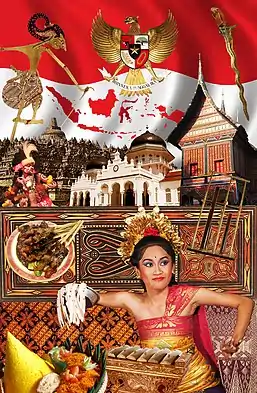 |
| History |
| People |
| Languages |
| Cuisine |
| Literature |
| Sport |
|
Examples of the fusion of Islam with Hinduism include Javanese Abangan belief. Balinese dances have stories about ancient Buddhist and Hindu kingdoms, while Islamic art forms and architecture are present in Sumatra, especially in the Minangkabau and Aceh regions. Traditional art, music and sport are combined in a martial art form called Pencak Silat.
The Western world has influenced Indonesia in science, technology and modern entertainment such as television shows, film and music, as well as political system and issues. India has notably influenced Indonesian songs and movies. A popular type of song is the Indian-rhythmical dangdut, which is often mixed with Arab and Malay folk music.
Despite the influences of foreign culture, some remote Indonesian regions still preserve uniquely indigenous culture. Indigenous ethnic groups Mentawai, Asmat, Dani, Dayak, Toraja and many others are still practising their ethnic rituals, customs and wearing traditional clothes.[1]
Traditional performing arts
Music
Indonesia is home to with those from the islands of Java, Sumatra and Bali being frequently recorded. The traditional music of central and East Java and Bali is the gamelan (traditional instruments include: gambang, bonang, saron, petik, gong, dengung, and many more).
On 29 June 1965, Koes Plus, a leading Indonesian pop group in the 1960s, 1970s and 1980s, was imprisoned in Glodok, West Jakarta, for playing Western-style music. After the resignation of President Sukarno, the law was rescinded, and in the 1970s the Glodok prison was dismantled and replaced with a large shopping mall.
Kroncong is a musical genre that uses guitars and ukulele as the main musical instruments. This genre had its roots in Portugal and was introduced by Portuguese traders in the 15th century. There is a traditional Keroncong Tugu music group in North Jakarta and other traditional Keroncong music groups in Maluku, with strong Portuguese influences. This music genre was popular in the first half of the 20th century; a contemporary form of Kroncong is called Pop Kroncong.
Angklung musical orchestra, native of West Java, received international recognition as UNESCO has listed the traditional West Java musical instrument made from bamboo in the list of intangible cultural heritage.[2][3]
The soft Sasando music from the province of East Nusa Tenggara in West Timor is completely different. Sasando uses an instrument made from a split leaf of the Lontar palm (Borassus flabellifer), which bears some resemblance to a harp.
- Some examples of Indonesian traditional music instruments



 Wooden Kolintang (Kolintang Kayu), traditional music instrument of Minahasa people in North Sulawesi, Indonesia
Wooden Kolintang (Kolintang Kayu), traditional music instrument of Minahasa people in North Sulawesi, Indonesia
Dance

Indonesian dance reflects the diversity of culture from ethnic groups that composed the nation of Indonesia. Austronesian roots and Melanesian tribal dance forms are visible, and influences ranging from neighbouring Asian countries; such as India, China, and Middle East to European western styles through colonization. Each ethnic group has its own distinct dances; makes total dances in Indonesia are more than 3000 Indonesian original dances. However, the dances of Indonesia can be divided into three eras; the Prehistoric Era, the Hindu/Buddhist Era, and the Era of Islam, and into two genres; court dance and folk dance.
During the Intergovernmental Committee for the Safeguarding of the Intangible Cultural Heritage convention in 29 November to 4 December 2015 in Windhoek, Namibia, UNESCO recognizes three genres of traditional dance in Bali, Indonesia, as Intangible cultural heritage.[4] The three genres includes Wali (sacred dances), Bebali (semi-sacred dances) and Balih-balihan (dances for entertainment purposes). Balinese dance has been proposed since 2011,[5] and officially recognized in 2015.
During the last few years, Saman from Nanggroe Aceh Darussalam has become rather popular and is often portrayed on TV. On November 24, 2011, UNESCO officially recognized Aceh's traditional Saman dance as an Intangible Cultural Heritage in Need of Urgent Safeguarding.[6][7][8]
There is a continuum in the traditional dances depicting episodes from the Ramayana and Mahabharata from India, ranging through Thailand, all the way to Bali. There is a marked difference, though, between the highly stylized dances of the courts of Yogyakarta and Surakarta and their popular variations. While the court dances are promoted and even performed internationally, the popular forms of dance art and drama must largely be discovered locally.
Reog Ponorogo is also a dance that originated from the district Ponorogo, East Java, which is a visualization of the legendary story Wengker kingdom and the kingdom of Kediri.
A popular line dance called Poco-poco was originated in Indonesia and also popular in Malaysia, but at early April 2011 Malaysian Islamic clerics banned the poco-poco dance for Muslims due to them believing it is traditionally a Christian dance and that its steps make the sign of the cross.[9]
- Some examples of Indonesian Traditional dance

_de_vader_van_de_bruid_Solo_TMnr_60020674.jpg.webp)

 The Sundanese Jaipongan Langit Biru dance performance in West Java Pavilion, Taman Mini Indonesia Indah, Jakarta
The Sundanese Jaipongan Langit Biru dance performance in West Java Pavilion, Taman Mini Indonesia Indah, Jakarta
Drama and theatre

The Wayang show, the Javanese, Sundanese, and Balinese shadow puppet theatre shows display several mythological legends such as Ramayana, Mahabharata, and many more. Wayang Orang is a Javanese traditional dance drama based on wayang stories. Various Balinese dance drama also can be included within the traditional form of Indonesian drama. Another form of local drama is Javanese Ludruk and Ketoprak, Sundanese Sandiwara, and Betawi Lenong. All of these dramas incorporated humour and jest, often involving audiences in their performance.
The shadow puppets are mostly made of sheets of certain items. You can make yours using wax paper and a sheet of translucent plastic, and download templates but those people really do have the talent to craft their own and one-of-a-kind shadow puppets, which are carved one by one segment out of metal or other special materials.[10][11]
UNESCO designated Wayang the flat leather shadow puppet (wayang kulit) and the three-dimensional wooden puppet (wayang golek or wayang klitik) theatre, as a Masterpiece of the Oral and Intangible Heritage of Humanity on 7 November 2003. In return for the acknowledgement, UNESCO required Indonesians to preserve the tradition.[12]
Randai is a folk theatre tradition of the Minangkabau people of West Sumatra, usually performed for traditional ceremonies and festivals. It incorporates music, singing, dance, drama and the silat martial art, with performances often based on semi-historical Minangkabau legends and love story.
Bangsawan is a Malay folk theatre found in the province of Riau.
Modern performing art also developed in Indonesia with their distinct style of drama. Notable theatre, dance, and drama troupe such as Teater Koma are gaining popularity in Indonesia as their drama often portray social and political satires of Indonesian society.[13]
- Some examples of Indonesian Dance Drama and Theatre
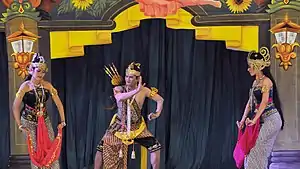


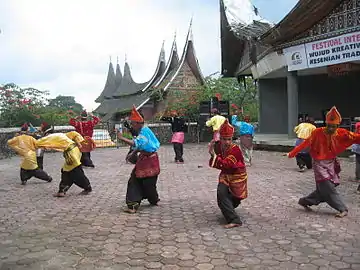
Martial arts
.jpg.webp)
The art of Pencak Silat was created and firstly developed in the islands of Java and Sumatra.[14] It is an art for survival and practised throughout the Indonesian archipelago. Centuries of tribal wars in Indonesian history had shaped silat as it was used by the ancient warriors of Indonesia. Silat was used to determine the rank and position of warriors in old Indonesian kingdoms.
Pencak Silat is recognized as a Masterpiece of the Oral and Intangible Heritage of Humanity by UNESCO (United Nations Educational, Scientific and Cultural Organization) on December 12th, 2019.[15]
Contacts with Indians and Chinese has further enriched silat. Silat reached areas beyond Indonesia mainly through the diaspora of Indonesian people. People from various regions like Aceh, Minangkabau, Riau, Bugis, Makassar, Java, Banjar, etc. moved into and settled in Malay Peninsula and other islands. They brought silat and passed it down to their descendants. The Indonesian of half-Dutch descent are also credited as the first to have brought the art into Europe.
Silat was used by Indonesian independence fighters during their struggle against the Dutch colonial rule. Unfortunately, after Indonesia achieving their independence, silat became less popular among Indonesian youth compare to foreign martial arts like Karate and Taekwondo. This probably because silat was not taught openly and only passed down among blood relatives, the other reason is the lack of media portrayal of the art.
Efforts have been made to introduce and reintroduce the beauty of silat to Indonesian youth and the world. Exhibitions and promotions by individuals as well as state-sponsored groups helped the growing of silat's popularity, particularly in Europe and United States. Indonesian 2009 Silat movie Merantau is one of Indonesian efforts to introduce silat to the international scene.
Another martial art from Indonesia is Tarung Derajat. It is a modern combat system created by Haji Ahmad Drajat based on his experience as a street fighter. Tarung Drajat has been acknowledged as a national sport by KONI in 1998 and is now used by Indonesian Army as part of their basic training.[16]
In Eastern Indonesia, there is a type of martial art hitting with a whip or stick. Caci is a form of fighting with a whip or stick. It appears to be indigenous to Flores in East Nusa Tenggara, but it is also practised in Bali and Lombok. There are two types of caci: with a whip (tereng or agang) or a stick (agang). The whip may be either long or short. The short whip corresponds to the cambuk of Java and measures 3 feet in length. The long whip is 5–6 feet long and made from palm stems tied together with either rattan or strips of water buffalo hide. The stick is an undecorated piece of hardwood measuring 1-1.5 yards long and 2 inches in diameter a caci match, the two fighters take turns alternately attacking and defending, a caci whip fight is performed by two contenders whom each opponent usually came from different villages. During early in the match, the contenders might go back and forth in prancing manners, thus jiggling and ringings the bells attached on his hips and ankles. This was meant as a provocation, initiated some moves to taunt each opponent and enliven the battle. While in the background musicians beat the drums and gongs.
- Some examples of Martial arts in Indonesia



 Caci (fighting) is one of the traditional martial arts of the Manggarai community in Flores Island, East Nusa Tenggara
Caci (fighting) is one of the traditional martial arts of the Manggarai community in Flores Island, East Nusa Tenggara
Traditional visual arts
Painting

What Indonesian painting before the 19th century are mostly restricted to the decorative arts, considered to be a religious and spiritual activity, comparable to the pre-1400 European art. Artists' names are anonymous since the individual human creator was seen as far less important than their creation to honour the deities or spirits. Some examples are the Kenyah decorative art, based on endemic natural motifs such as ferns and hornbills, found decorating the walls of Kenyah longhouses. Other notable traditional art is the geometric Toraja wood carvings. Balinese paintings are initially the narrative images to depict scenes of Balinese legends and religious scripts. The classical Balinese paintings are often decorating the lontar manuscripts and also the ceilings of temples pavilion.
The oldest known cave paintings are more than 44,000 years old (art of the Upper Paleolithic), found in both the Franco-Cantabrian region in western Europe, and in the caves in the district of Maros (Sulawesi, Indonesia). The oldest type of cave paintings are hand stencils and simple geometric shapes; the oldest undisputed examples of figurative cave paintings are somewhat younger, close to 35,000 years old.[17]

In 2018, scientists reported the discovery of the then-oldest known figurative art painting, over 40,000 (perhaps as old as 52,000) years old, of an unknown animal, in the cave of Lubang Jeriji Saléh on the Indonesian island of Borneo. In December 2019, however, figurative cave paintings depicting pig hunting in the Maros-Pangkep karst in Sulawesi were estimated to be even older, at at least 43,900 years old. The finding was noted to be “the oldest pictorial record of storytelling and the earliest figurative artwork in the world”.[18][19]
Under the influence of the Dutch colonial power, a trend toward Western-style painting emerged in the 19th century. In the Netherlands, the term "Indonesian Painting" is applied to the paintings produced by Dutch or other foreign artists who lived and worked in the former Netherlands-Indies. The most famous indigenous 19th-century Indonesian painter is Raden Saleh (1807–1877), the first indigenous artist to study in Europe. His art is heavily influenced by Romanticism.[20] In the 1920s Walter Spies settled in Bali, he is often credited with attracting the attention of Western cultural figures to Balinese culture and art. His works have somehow influenced Balinese artists and painters. Today Bali has one of the most vivid and richest painting traditions in Indonesia.
The 1920s to 1940s were a time of growing nationalism in Indonesia. The previous period of romanticism movement was not seen as a purely Indonesian movement and did not develop. Painters began to see the natural world for inspiration. Some examples of Indonesian painter during this period are the Balinese Ida Bagus Made and the realist Basuki Abdullah. The Indonesian Painters Association (Persatuan Ahli-Ahli Gambar Indonesia or PERSAGI, 1938–1942) was formed during this period. PERSAGI established a contemporary art philosophy that saw artworks as reflections of the artist's individual or personal view as well as an expression of national cultural thoughts.
From the 1940s on, artists started to mix Western techniques with Southeast Asian imagery and content. Painters that rooted in the revolutionary movement of the World War and the post-World War period started to appear during this period, such as Sudjojono, Affandi, and Hendra.[21]
During the 1960s, new elements were added when abstract expressionism and Islamic art began to be absorbed by the art community. Also during this period, group of painters that are more concerned about the reality of Indonesian society began to appear, taking inspiration from the social problem such as the division between the rich and the poor, pollution, and deforestation. The national identity of Indonesia was stressed by these painters through the use of a realistic, documentary style. During the Sukarno period, this socially-engaged art was officially promoted, but after 1965 it lost popularity due to its presumed communist tendencies.[22]
Three art academies offer extensive formal training in visual art: Bandung Institute of Technology founded in 1947; the Akademi Seni Rupa Indonesia (Indonesian Fine Arts Academy) or ASRI, now known as ISI, in Yogyakarta was inaugurated in 1950; and the Institut Kesenian Jakarta (Jakarta Arts Institute) or IKJ, was opened in 1970.
- Some examples of Indonesian paintings
 Pre-1920 Kamasan Palindon Painting detail, an example of Kamasan-style classical painting
Pre-1920 Kamasan Palindon Painting detail, an example of Kamasan-style classical painting
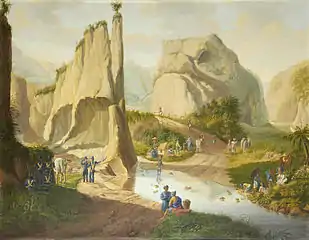
.jpg.webp) Mask Dancer, A.A. Gde Anom Sukawati (b. 1966), Acrylic on canvas
Mask Dancer, A.A. Gde Anom Sukawati (b. 1966), Acrylic on canvas
Wood carvings

The art of wood carving is quite well-developed in Indonesia. Other than tribal art woodcarvings of Asmat, Batak, Dayak, Nias, and Toraja area is well known for its refined wood carving culture; they are Jepara in Central Java and Bali. Mas village near Ubud in Bali is renowned for their wood carving art. Balinese woodcarving today has a sustained tourist market in Bali.
Asmat art consists of elaborate stylized wood carvings such as the bisj pole and is designed to honour ancestors. Many Asmat artefacts have been collected by the world's museums, among the most notable of which are those found in the Michael C. Rockefeller Collection at the Metropolitan Museum of Art in New York City and the Tropenmuseum in Amsterdam. Bisj poles are carved by Asmat religious carvers (wow-ipits) after a member of their tribe or community had been killed and headhunted by an enemy tribe. Carved out of a single piece of a wild mangrove tree, Bisj poles can reach heights of up to 25 feet (7.62 m). Their carvings depict human figures standing on top of each other, as well as animal figures, phallic symbols, and carvings in the shape of a canoe prow. The Asmat participated in headhunting raids and cannibalism as rituals, many rituals involved the Bisj poles, including dancing, masquerading, singing and headhunting—all performed by men. Bisj poles often had a receptacle at the base that was meant to hold the heads of enemies taken on headhunting missions. The phallic symbols represented the strength and virility of the community's ancestors as well as of the warriors going on the headhunting mission. Canoe prow symbols represented a metaphorical boat that would take the deceased spirits away to the afterlife. The human figures would represent deceased ancestors.
The people of Nias placed great value on wooden figures or adu. The sole purpose of the Nias figures was to fulfil ritual needs, whether it is to ensure wealth or to perform the specific beneficial rite. Niassan figures vary in size, from as small as 20 centimetres (7.9 in) in height to more than 2 metres (6.6 ft) tall. When an elderly person died, the family would make a wooden statue known as adu zatua. The shape of the wooden statue reflects the status of the person who used them: the more powerful the owner, the more impressive the statue will be made. Missionary work in 1930 had recorded the removal of 'over 2000 "idols" from a house of a new northern convert.' Some missionary even recorded collapsing houses under the weight of these ancestor figures. Small adu zatua were bound together horizontally using rattan and pegs.
Torajans carve wood, calling it Pa'ssura (or "the writing"). Wood carvings are therefore Toraja's cultural manifestation. Each carving receives a special name, and common motifs are animals and plants that symbolise some virtue. For example, water plants and animals, such as crabs, tadpoles and water weeds, are commonly found to symbolise fertility. In some areas, noble elders claim these symbols refer to the strength of a noble family, but not everyone agrees. Other Torajans carve wood is Tau tau, Tau tau is a type of effigy made of wood or bamboo. Torajans believe that the dead can take their possessions with them to the afterlife, the effigies are usually equipped with small possessions.
Traditionally, the effigies were simply carved, only to show the gender of the deceased. However, they have become more and more elaborate, actually attempting to imitate the likeness of the deceased. Nowadays, Tau tau has a photographic likeness to the people they represent. They are carved with wrinkles and carry items like Bibles. The types of wood used for the effigies and what they are clothed in also reflect the status and wealth of the deceased. The tau tau is representatives of the deceased, ever-guarding the tombs and ever-protecting the living. The types of wood used for the effigies and what they are clothed in also reflect the status and wealth of the deceased. Tau tau of the wealthy would generally be made of wood from the jackfruit tree. They are usually permanent statues that can be found standing at the entrance of tombs, which are carved out of rock faces of Toraja.
- Some examples of Indonesian wood carving for rituals
 The Nias adu zatua (wooden ancestor statues)
The Nias adu zatua (wooden ancestor statues).jpg.webp) Toraja stone-carved burial site. Tau tau (wooden statue of the deceased) were put in the cave, looking out over the land, in South Sulawesi
Toraja stone-carved burial site. Tau tau (wooden statue of the deceased) were put in the cave, looking out over the land, in South Sulawesi A Pair of Loro Blonyo from Java
A Pair of Loro Blonyo from Java
Sculpture
Indonesia has a long history of stone, bronze and Iron Ages arts. The megalithic sculptures can be found in numerous archaeological sites in Sumatra, Java to Sulawesi. The native Indonesians tribes have their own distinct tribal sculpture styles, usually created to depict ancestors, deities and animals. The stone sculpture artform particularly flourished in 8th-to-10th-century Java and Bali, which demonstrate the influences of Hindu-Buddhist culture, both as stand-alone works of art and also incorporated into temples. Most notable sculpture of classical Hindu-Buddhist era of Indonesia are the hundreds of meters of relief and hundreds of stone buddhas at the temple of Borobudur in central Java. Approximately two miles of exquisite relief sculpture tell the story of the life of Buddha and illustrate his teachings. The temple was originally home to 504 statues of the seated Buddha. This site, as with others in central Java, show a clear Indian influence.
The examples of notable Indonesian Hindu-Buddhist sculptures are; the statues of Hindu deities; Shiva, Vishnu, Brahma, Durga, Ganesha and Agastya enthroned in rooms of Prambanan temples, the Vishnu mounting Garuda statue of king Airlangga, the exquisite statue of Eastern Javanese Prajnaparamita and 3.7 meters tall Dvarapala dated from Singhasari period, and also the grand statue of Bhairava Adityawarman discovered in Sumatra. Today, the Hindu-Buddhist style stone sculptures are reproduced in villages in Muntilan near Borobudur also in Trowulan the former capital site of Majapahit in East Java, and Bali, and sold as garden or pool ornament statues for homes, offices and hotels.
The walls of candi also often displayed bas-reliefs, either serve as decorative elements as well as to convey religious symbolic meanings; through describing narrative bas-reliefs. The most exquisite of the temple bas-reliefs can be found in Hindu and Buddhist temples. The first four terraces of Borobudur walls are showcases for bas-relief sculptures. These are exquisite, considered to be the most elegant and graceful in the ancient Buddhist world.[23] The Buddhist scriptures describes as bas-reliefs in Borobudur such as Karmavibhangga (the law of karma), Lalitavistara (the birth of Buddha), Jataka, Avadana and Gandavyuha. While in Prambanan the Hindu scriptures is describes in its bas-relief panels; the Ramayana and Bhagavata Purana (popularly known as Krishnayana). The Buddhist scriptures describes as bas-reliefs in Borobudur such as Karmavibhangga (the law of karma), Lalitavistara (the birth of Buddha), Jataka, Avadana and Gandavyuha. While in Prambanan the Hindu scriptures is describes in its bas-relief panels; the Ramayana and Bhagavata Purana (popularly known as Krishnayana).
The bas-reliefs in Borobudur depicted many scenes of daily life in 8th-century ancient Java, from the courtly palace life, hermit in the forest, to those of commoners in the village. It also depicted a temple, marketplace, various flora and fauna, and also native vernacular architecture. People depicted here are the images of king, queen, princes, noblemen, courtier, soldier, servant, commoners, priest and hermit. The reliefs also depicted mythical spiritual beings in Buddhist beliefs such as asuras, gods, boddhisattvas, kinnaras, gandharvas and apsaras. The images depicted on bas-relief often served as a reference for historians to research for certain subjects, such as the study of architecture, weaponry, economy, fashion, and also the mode of transportation of 8th-century Maritime Southeast Asia. One of the famous renderings of an 8th-century Southeast Asian double outrigger ship is Borobudur Ship.
Today in Indonesia, the richest, most elaborate and vivid wooden sculpture and wood carving traditions can be found in Bali and Jepara, Central Java. Balinese and Javanese handicrafts such as sculptures, masks, and other carving artworks are popular souvenirs for tourist that have visited Indonesia. On the other hand, the Jepara wood carving is famous for its elaborately carved wooden furniture, folding screens also pelaminan gebyok (wedding throne with carved background).
- Some examples of Indonesian Scultures

 Timor statue in Padadita Beach, Waingapu, East Sumba, East Nusa Tenggara
Timor statue in Padadita Beach, Waingapu, East Sumba, East Nusa Tenggara.jpg.webp) Bas relief sculpture from the Borobudur temple
Bas relief sculpture from the Borobudur temple
Architecture
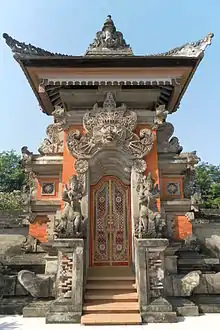
For centuries, the Indonesian vernacular architecture has shaped settlements in Indonesia which commonly took the form of timber structures built on stilts dominated by a large roof. The most dominant foreign influences on Indonesian architecture were Indian, although European influences have been particularly strong since the 19th century and modern architecture in Indonesia is international in scope.

As in much of South East Asia, traditional vernacular architecture in Indonesia is built on stilts, with the significant exceptions of Java and Bali. Notable stilt houses are those of the Dayak people in Borneo, the Rumah Gadang of the Minangkabau people in western Sumatra, the Rumah Bolon of the Batak people in northern Sumatra, and the Tongkonan of the Toraja people in Sulawesi. Oversized saddle roofs with large eaves, such as the homes of the Batak and the tongkonan of Toraja, are often bigger than the house they shelter. The fronts of Torajan houses are frequently decorated with buffalo horns, stacked one above another, as an indication of status. The outside walls also frequently feature decorative reliefs.
Candi is an Indonesian term to refer to ancient temples. Before the rise of Islam, between the 5th to 15th-century Dharmic faiths (Hinduism and Buddhism) were the majority in the Indonesian archipelago, especially in Java and Sumatra. As a result of numerous Hindu temples, locally known as candi, constructed and dominated the landscape of Java. According to local beliefs, Java valley had thousands of Hindu temples which co-existed with Buddhist temples, most of which were buried in the massive eruption of Mount Merapi in 1006 AD.

Between 1100 and 1500 additional Hindu temples were built, but abandoned by Hindus and Buddhists as Islam spread in Java circa 15th to 16th century. The 8th-century Borobudur temple near Yogyakarta is the largest Buddhist temple in the world and is notable for incorporating about 2,672 relief panels and 504 Buddha statues into its structure, telling the story of the life of the Buddha. As the visitor ascends through the eight levels of the temple, the story unfolds, the final three levels simply containing stupas and statues of the Buddha. The building is said to incorporate a map of the Buddhist cosmos and is a masterful fusion of the didactic narrative relief, spiritual symbolism, monumental design and the serene meditative environs. The whole monument itself resembles a giant stupa, but seen from above it forms a mandala.[24]
The nearby 9th-century temple complex at Prambanan contains some of the best-preserved examples of Hindu temple architecture in Java. The temple complex comprises eight main shrines, surrounded by 224 smaller shrines. The Indian influence on the site is clear, not only in the style of the monument, but also in the reliefs featuring scenes from the Ramayana which adorn the outer walls of the main temples, and in the votive statuary found within. Majority of Hindu temples in Java were dedicated to Shiva, who Javanese Hindus considered as the God who commands the energy to destroy, recombine and recreate the cycle of life. Small temples were often dedicated to Shiva and his family (wife Durga, son Ganesha). Larger temple complexes include temples for Vishnu and Brahma, but the most majestic, sophisticated and central temple was dedicated to Shiva.
- Some examples of Architecture in Place of worships and traditional house in Indonesia







_01.jpg.webp)
Crafts

Indonesia is considered as home of world handicraft.[25] Every ethnic group has its own uniqueness, style, and philosophy of crafting.[25] Most of them are made from wooden, bone, fabric, stone, and paper. These natural materials were crafted using hands into profitable and aesthetic items.[25] Handicraft manufacturing serves not only as an important economic sector, but also a tradition and has a social function as well.[26] The handicraft industry employs thousands of people in towns and villages across the country. About half a billion dollar worth of handicraft is exported every year, and many more is consumed domestically.[25][26]
There are many varieties of handicraft from other regions.[25] West Sumatra and South Sumatra are particularly noted for their songket cloths.[27] Villages in the Lesser Sunda Islands produce ikat while provinces in Kalimantan are long known for their basketry and weaving using rattan and other natural fabrics.[28] Wood art produced by the Asmat people of Papua is highly valued.[29] Cities along Java's northern coast, Cirebon, Pekalongan, and Rembang are known as centres of batik.[30] Cirebon and Jepara are important cities in furniture, producing rattan and carved wood respectively,[31] while Tasikmalaya is known for embroidery.[32] Pasuruan also produces furniture and other products and support stores and galleries in Bali.[25] Bandung and Surabaya, both modern, cosmopolitan, and industrialised cities—much like Jakarta but on a lesser scale—are creative cities with a variety of innovative startups.[25]
Several Indonesian islands are famous for their batik, ikat and songket cloth. Once on the brink of disappearing, batik and later ikat, found a new lease on life when former President Suharto promoted wearing batik shirts on official occasions. In addition to the traditional patterns with their special meanings, used for particular occasions, batik designs have become creative and diverse over the last few years.
Other noted Indonesian crafts are Jepara wood carving[33] and Kris. In 2005, UNESCO recognised Kris as one of Masterpiece of the Oral and Intangible Heritage of Humanity from Indonesia.[34]
In 2012, Noken was listed in the UNESCO Intangible Cultural Heritage Lists as a cultural heritage of Indonesia.[35] Women carrying noken are still a common sight in Wamena.[36]
Being the best-known Indonesian sailing-vessel, Phinisi became the tagline for the 2017 inscription of ''The Art of Boatbuilding in South Sulawesi'' in the UNESCO's Representative List of the Intangible Cultural Heritage of Humanity.
- Some Indonesian Traditional Weapons
_met_rechthoekig_gebogen_hoornen_greep_en_houten_schede_TMnr_17-5.jpg.webp)
.jpg.webp)
_with_Sheath_MET_36.25.873ab_003july2014.jpg.webp)

Clothing
Indonesia's best-known national costumes are Batik and kebaya, although initially these costumes originated mainly from Javanese and Balinese culture, which are most prominent in Javanese, Sundanese and Balinese cultures. Because Java has become the political centre and population of Indonesia, the island's folk costume has been raised to national status. As a plural country, Indonesia has 34 provinces, each of which has representatives of traditional clothing from each province with unique and different designs. National costumes are worn at official occasions and traditional ceremonies. each province in Indonesia – more complete each group in Indonesia, has its own traditional costumes. The costumes of this area are in Indonesian called Pakaian tradisional or Pakaian adat, and are taken from traditional Indonesian textile traditions and crafts.
Batik

Batik is a cloth that is traditionally made using a manual wax-resist dyeing technique to form intricate patterns. Traditionally batik cloth is a large piece of intricately decorated cloth used by Javanese women as kemben or torso wrap. Batik cloth was wrapped around the hips with multiple folds in front called wiron, while the upper torso wear kebaya fitted dress. Traditionally for men, the edge of batik cloth also can be sewn together to make a tubular cloth as sarong, or wrapped around hips as kain in a fashion similar to women's. Later for men, the batik cloth also is sewn and made into contemporary batik men's shirt. Today, Batik shirts, which are commonly worn by men in Indonesia (especially in Java), are usually worn during formal occasions; such as attending weddings, traditional ceremonies, formal meetings, communal gatherings, etc. Batik is recognized as one of the important identity of Indonesian culture. UNESCO designated Indonesian batik as a Masterpiece of Oral and Intangible Heritage of Humanity on October 2, 2009.[37]
Kebaya

The kebaya is the national costume of women from Indonesia, although it is more accurately endemic to the Javanese, Sundanese and Balinese peoples. It is sometimes made from sheer material such as silk, thin cotton or semi-transparent nylon or polyester, adorned with brocade or floral pattern embroidery. Kebaya usually worn with a sarong or batik kain panjang, or other traditional woven garment such as ikat, songket with a colorful motif. Kebaya is usually worn during official national events by Indonesian first lady, wives of Indonesian diplomats, and Indonesian ladies. It also worn by Indonesian ladies attending traditional ceremonies and weddings. During Balinese traditional ceremonies, Balinese women wore colorful Balinese style kebaya with songket Bali.
Peci
The Peci, also known as songkok or kopiah, is a cap traditionally worn by male Muslims in the Indonesian archipelago. It is quite similar to the Turkish-Egyptian fez. In Indonesia, the black velvet peci has become the national headdress with nationalist connotations made popular by Sukarno.[38] A number of Indonesian nationalist movement activists in the early 20th century, wore a peci to convey their nationalistic sentiments and to demonstrate their Indonesian identity. Indonesian male presidents always wear a peci as part of their official presidential attire. Since then, the black velvet peci is approved to be the national head-dress for Indonesian men. It is worn all over Indonesia, especially by government officials and men (usually Muslim men) throughout the country. The peci is usually worn with batik shirt or western-style suits by men in Indonesia for those attending formal occasions.
- Some Indonesian Traditional Fabrics




Foods

The cuisine of indonesia has been influenced by Chinese culture and Indian culture, as well as by Western culture. However, in return, Indonesian cuisine has also contributed to the cuisines of neighbouring countries, notably Malaysia and Singapore, where Padang or Minangkabau cuisine from West Sumatra is very popular. Also, Satay (Sate in Indonesian), which originated from Java, Madura, and Sumatra, has gained popularity as a street vendor food from Singapore to Thailand. In the 15th century, both the Portuguese and Arab traders arrived in Indonesia with the intention of trading for pepper and other spices. During the colonial era, immigrants from many countries arrived in Indonesia and brought different cultures as well as cuisines.

Most native Indonesians eat rice as the main dish, with a wide range of vegetables and meat as side dishes. However, in some parts of the country, such as Irian Jaya and Ambon, the majority of the people eat sago (a type of tapioca) and sweet potato. In some places, people eat Pempek, a type of Indonesian traditional dish, and also Rendang (refer to picture on top-left of this topic {FOODS}.
The most important aspect of modern Indonesian cuisine is that food must be halal, conforming to Islamic food laws. Haraam, the opposite of halal, includes pork and alcohol. However, in some regions where there is a significant non-Muslim population, non-halal foods are also commonly served.

Indonesian dishes are usually spicy, using a wide range of chilli peppers and spices. The most popular dishes include nasi goreng (fried rice), Satay, Nasi Padang (a dish of Minangkabau) and soy-based dishes, such as tofu and tempe. A unique characteristic of some Indonesian food is the application of spicy peanut sauce in their dishes, as a dressing for Gado-gado or Karedok (Indonesian style salad), or for seasoning grilled chicken satay. Another unique aspect of Indonesian cuisine is using terasi or belacan, a pungent shrimp paste in dishes of sambal oelek (hot pungent chilli sauce). The sprinkling of fried shallots also gives a uniquely crisp texture to some Indonesian dishes.
Chinese and Indian cultures have influenced the serving of food and the types of spices used. It is very common to find Chinese food in Indonesia such as Dim Sum and noodles, and Indian cuisine such as Tandoori chicken. In addition, Western culture has significantly contributed to the extensive range of dishes. However, the dishes have been transformed to suit Indonesian tastes. For example, steaks are usually served with rice. Popular fast foods such as Kentucky Fried Chicken are served with rice instead of bread and sambal (spicy sauce) instead of ketchup. Some Indonesian foods have been adopted by the Dutch, like Indonesian rice table or 'rijsttafel'.
- Some national dishes of Indonesia




Mythology
The mythology of Indonesia is very diverse, the Indonesian people consisting of hundreds of ethnic groups, each with their own myths and legends. The stories within this system of lore often incorporate supernatural entities and magical creatures which form parts of the Indonesian mythology. Others relate to creation myths and place naming legends that are often intertwined with historical figures and events. Ancient rituals for healing and traditional medicine as well as complex philosophies regarding health and disease can also be found.
These native mythologies are relatively free from foreign influences, such as Torajans, Nias, Bataks, Dayaks and Papuans. By contrast, Javanese, Balinese, and to some degree Sundanese were influenced by Hindu-Buddhist Indian mythology as early as the 1st century CE. Hindu gods, legends and epics such as Ramayana and Mahabharata were adopted and adapted into a uniquely local form.
Hindu-Buddhist mythical beings have a role in Javanese and Balinese mythology, including of Hindu gods and heroes, devatas, asuras, apsaras (known as hapsari or bidadari), kinnaras, etc., while native gods of nature such as Semar, Dewi Sri, and Nyai Loro Kidul are either given identified as their Hindu counterpart or incorporated into a Java-Bali Hindu pantheon unknown in India. For example, native rice goddess Dewi Sri is identified with Lakshmi the shakti of Vishnu, and Semar and his sons the Punakawans are incorporated into the epic of Mahabharata in Javanese wayang kulit, as the clown servants of the Pandawas. Several names refer to gods, such as Dewa (devas), Dewi (devi), dewata (devatas), and in native traditions usually referred to as Batara (male god) and Batari (female goddess).
After the coming of Islam to the Indonesian archipelago, Islamic mythology especially those dealing with spiritual beings, such as devils, demons, jinns and angels entered Indonesian mythology. In Sumatra, Malay, Aceh and Minangkabau mythology was almost entirely supplanted by Islamic mythology. However, belief in local spirits such as the forest guardian, the ghost of water or haunted places still exists, often associated with a jinn or the tormented soul of a deceased human.
- Some mythological creatures in Indonesia


.jpg.webp) Lembuswana
Lembuswana
Literature
Early Indonesian literature originates in Malay literature, and the influence of these roots was felt until well into the twentieth century. The phrase "Indonesian literature" refers to Indonesian as written in the nation of Indonesia, but also covers literature written in an earlier form of the language, i.e. the Malay language written in the Dutch East Indies. Pramoedya Ananta Toer was Indonesia's most internationally celebrated author, having won the Magsaysay Award as well as being considered for the Nobel Prize in Literature. Other important figures include the late Chairil Anwar, a poet and member of the "Generation 45" group of authors who were active in the Indonesian independence movement. Tight information controls during Suharto's presidency suppressed new writing, especially because of its ability to agitate for social reform.
In the book Max Havelaar, Dutch author Multatuli criticised the Dutch treatment of the Indonesians, which gained him international attention.
Modern Indonesian authors include Seno Gumira Adjidarma, Andrea Hirata, Habiburrahman El Shirazy, Ayu Utami, Gus tf Sakai, Eka Kurniawan, Ratih Kumala, Dee, Oka Rusmini. Some of their works have translated to other languages.
Poetry
There is a long tradition in Indonesia, particularly among ethnically Malay populations, of extemporary, interactive, oral composition of poetry. These poems are referred to as pantun. Contemporary Indonesian poets include among others, Sutardji Calzoum Bachri, Rendra, Taufiq Ismail, Afrizal Malna, Binhad Nurrohmat, Joko Pinurbo, Sapardi Djoko Damono. In written poetry and prose, a number of traditional forms dominate, mainly: syair (traditional narrative poetry), gurindam (brief aphorisms), hikayat (stories, fairy-tales, animal fables, chronicles), babad (histories or chronicles).
On 15 December 2020 the Pantun is recognized as a Masterpiece of the Oral and Intangible Heritage of Humanity by UNESCO (United Nations Educational, Scientific and Cultural Organization).
Recreation and sports


Many traditional games are still preserved and popular in Indonesia, although western culture has influenced some parts of them. Among three hundred officially recognised Indonesian cultures, there are many kinds of traditional games: cockfighting in Bali, annual bull races in Madura, and stone jumping in Nias. Stone jumping involves leaping over a stone wall about up to 1.5 m high and was originally used to train warriors. Pencak Silat is another popular form of sport, which was influenced by Asian culture as a whole. Another form of national sport is sepak takraw.[39] The rules are similar to volleyball: to keep the rattan ball in the air with the players' feet.
Popular modern sports in Indonesia played at the international level include football (soccer), badminton and basketball.[40] Badminton is one of Indonesia's most successful sports. Indonesian badminton athletes have played in Indonesia Open Badminton Championship, All England Open Badminton Championships, and many international events, including the Summer Olympics and won Olympic gold medals since badminton was made an Olympic sport in 1992. Rudy Hartono is a legendary Indonesian badminton player, who won All England titles seven times in a row (1968 through 1974). Indonesian teams have won the Thomas Cup (men's world team championship) thirteen of the twenty-two times that it has been contested since they entered the series in 1957.[41] In the internationally popular sport of football (soccer), Indonesian teams have been active in the Asian Football Confederation (AFC).
Sporting events in Indonesia are organised by the Indonesian National Sports Committee (KONI). The Committee, along with the government of Indonesia, has set a National Sports Day on every 9 September with "Sports for All" as the motto. Indonesia has hosted the Southeast Asian Games four times, in 1979, 1987, 1997 and 2011, and won overall champion title in each of these years. As of 2011, Indonesia has won champion titles 10 times overall out of 18 SEA Games it has attended since debuted in 1977. The country also hosted the 1993 Asian Basketball Championship.[42]
- Some Indonesian Traditional Sports

 Egrang
Egrang Tarik Tambang
Tarik Tambang Pacuan Kuda
Pacuan Kuda
Popular media
Cinema
The largest chain of cinemas in Indonesia is 21 Cineplex, which has cinemas spread throughout twenty-four cities on the major islands of Indonesia. Many smaller independent cinemas also exist.
In the 1980s, the film industry in Indonesia was at its peak, and dominated the cinemas in Indonesia with movies that have retained a high reputation, such as Catatan Si Boy and Blok M and actors like Onky Alexander, Meriam Bellina, Nike Ardilla and Paramitha Rusady.[43] The film Tjoet Nja' Dhien (1988) winning 9 Citra Awards at the 1988 Indonesian Film Festival.[44] It was also the first Indonesian movie chosen for screening at the Cannes Film Festival,[44] where it was awarded Best International Film in 1989.[45] However, the film industry failed to continue its successes in the 1990s, when the number of movies produced decreased significantly, from 115 movies in 1990 to just 37 in 1993.[46] As a result, most movies produced in the 1990s contained adult themes. The industry started to recover in the late 1990s, with the rise of independent directors and many new movies produced, such as Garin Nugroho's Cinta dalam Sepotong Roti, Riri Riza and Mira Lesmana's Petualangan Sherina and Arisan! by Nia Dinata.[43] Another form of recovery is the re-establishment of the Indonesian Film Festival (FFI), inactive for twelve years, and the creation of the Jakarta International Film Festival. Daun di Atas Bantal (1998) received Asia Pacific Film Festival in Taipei.[47]
Television
Radio
The state radio network Radio Republik Indonesia (RRI) was founded in 1945. It consists of a network of regional stations located in all thirty-three provinces of the archipelago. In most cities and large towns there are also many commercial stations. Since 2006, several digital radio stations have been based in Jakarta and Surabaya, using Digital Audio Broadcasting (DAB) and Hybrid HD-Radio.[48][49][50]
Religion and philosophy
Islam is Indonesia's main religion, with almost 88% of Indonesians declared Muslim according to the 2000 census,[51] making Indonesia the most populous Muslim-majority nation in the world. The remaining population is 9% Christian (of which roughly two-thirds are Protestant with the remainder mainly Catholic, and a large minority Charismatic), 2% Hindu, and 1% Buddhist.
The Pancasila, the statement of two principles which encapsulate the ideology of the Indonesian state, affirms that "The state shall be based on the belief in the one and only God".
- Some Indonesian ritual worship
 Indonesian Muslim wedding procession
Indonesian Muslim wedding procession
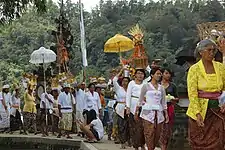
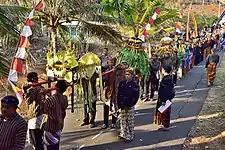 Labuhan procession in Yogyakarta is believed to help preserve the balance of nature
Labuhan procession in Yogyakarta is believed to help preserve the balance of nature
Ethnic groups
- Some ethnic groups in Indonesia




Celebrations
| Date (Gregorian Calendar) | Date (Religious Calendar) | English Name | Local Name | Remarks |
|---|---|---|---|---|
| 1 January | New Year's Day | Tahun Baru Masehi | ||
| Rabi' al-awwal 12 | Birth of the Prophet | Maulid Nabi Muhammad | Birthday of the Islamic Prophet Muhammad | |
| January–February | Chinese New Year | Tahun Baru Imlek | 1st day of 1st month of Chinese Calendar | |
| March | Kasa 1 Pawukon 40 | Day of Silence | Hari Raya Nyepi (Tahun Baru Saka) | New Year of Balinese calendar |
| March–April | Good Friday | Wafat Yesus Kristus/Isa Almasih (Jumat Agung) | Date varies; this is the Friday before Easter Sunday, which is the first Sunday after the first Paschal Full Moon following the official vernal equinox | |
| 1 May | Labour Day | Pekerja | ||
| May–June | Ascension of Jesus Christ | Kenaikan Yesus Kristus/Isa Almasih | ||
| May | Every May of Vaisakha | Buddha's Birthday | Waisak | In Indonesia it is celebrated as Trisuci Waisak, to commemorate three important events in Buddhism; Buddha's birthday, enlightenment and his death. The date varies according to the Buddhist calendar |
| Rajab 27 | Ascension of the Prophet | Isra Mi'raj Nabi Muhammad | ||
| 1 June | Pancasila Day | Hari Lahir Pancasila | Public holiday since 2016, marks the date of Sukarno's 1945 address on the national ideology | |
| 17 August | Independence Day | Hari Proklamasi Kemerdekaan R.I. | Sukarno and Mohammad Hatta as the proclaimers | |
| Shawwal 1–2 | Day after Ramadan | Idul Fitri (Lebaran Mudik) | Date varies according to the Islamic calendar | |
| Dhu al-Hijjah 10 | Feast of the Sacrifice | Idul Adha (Lebaran Haji) | Date varies according to the Islamic calendar | |
| Muharram 1 | Islamic New Year | Tahun Baru Hijriyah | 1st day of the Muharram, the beginning of the new Islamic year | |
| 25 December | Christmas | Hari Natal | ||
See also
References
- Taylor, Jean Gelman (2003). Indonesia peoples and Histories. ISBN 0-300-10518-5.
- "Indonesian Angklung". Unesco.org. Retrieved 21 August 2017.
- "UNESCO grants Indonesia's angklung cultural heritage title". News.xinhuanet.com. Archived from the original on 8 July 2013. Retrieved 21 August 2017.
- "Traditional dances, crafts, knowledge and music on the agenda at Intangible Heritage Committee meeting in Namibia". UNESCO. Retrieved 1 December 2015.
- "Traditional dances proposed to be world's heritage". The Jakarta Post. 16 November 2011. Retrieved 1 December 2015.
- ""Saman dance", Inscribed in 2011 (6.COM) on the List of Intangible Cultural Heritage in Need of Urgent Safeguarding List". UNESCO. Retrieved 10 October 2014.
- "UNESCO officially recognizes Saman Dance as part of intangible cultural heritage, UNESCO". 24 November 2011. Archived from the original on 27 November 2011.
- "9 Properti Tari Saman (Lengkap beserta gambar dan deskripsi)".
- "Archived copy". Archived from the original on 4 April 2011. Retrieved 4 April 2011.CS1 maint: archived copy as title (link)
- Ness, Edward C. Van; Prawirohardjo, Shita (1980). Javanese Wayang Kulit: An Introduction. Oxford University Press. ISBN 9780195804140.
- Miyao, J. (1977). "P. L. Amin Sweeney and Akira Goto (ed.) An International Seminar on the Shadow Plays of Asia". Southeast Asia: History and Culture. Japan Society for Southeast Asian Studies (7): 142–146. doi:10.5512/sea.1977.142.
- ""Wayang puppet theatre", Inscribed in 2008 (3.COM) on the Representative List of the Intangible Cultural Heritage of Humanity (originally proclaimed in 2003)". UNESCO. Retrieved 10 October 2014.
- Yves Bonnefoy (1993). Asian Mythologies. University of Chicago Press. p. 162. ISBN 978-0-226-06456-7.
- Donn F. Draeger (1992). Weapons and fighting arts of Indonesia. Rutland, Vt. : Charles E. Tuttle Co. ISBN 978-0-8048-1716-5.
- "'Pencak silat' given UNESCO intangible world heritage distinction". The Jakarta Post. Retrieved 13 December 2019.
- Donn F. Draeger (1992). Weapons and fighting arts of Indonesia. Rutland, Vt. : Charles E. Tuttle Co. ISBN 978-0-8048-1716-5.
- M. Aubert et al., "Pleistocene cave art from Sulawesi, Indonesia", Nature volume 514, pages 223–227 (09 October 2014). "using uranium-series dating of coralloid speleothems directly associated with 12 human hand stencils and two figurative animal depictions from seven cave sites in the Maros karsts of Sulawesi, we show that rock art traditions on this Indonesian island are at least compatible in age with the oldest European art. The earliest dated image from Maros, with a minimum age of 39.9 kyr, is now the oldest known hand stencil in the world. In addition, a painting of a babirusa (‘pig-deer’) made at least 35.4 kyr ago is among the earliest dated figurative depictions worldwide, if not the earliest one. Among the implications, it can now be demonstrated that humans were producing rock art by ∼40 kyr ago at opposite ends of the Pleistocene Eurasian world."
- Aubert, M.; et al. (11 December 2019). "Earliest hunting scene in prehistoric art". Nature. 576 (7787): 442–445. doi:10.1038/s41586-019-1806-y. PMID 31827284. S2CID 209311825.
- Ferreira, Becky (11 December 2019). "Mythical Beings May Be Earliest Imaginative Cave Art by Humans - The paintings on an Indonesian island are at least 43,900 years old and depict humanoid figures with animal-like features in a hunting scene". The New York Times. Retrieved 12 December 2019.
- Hilda Soemantri, ed. Indonesian Heritage: Visual Art. Singapore: Didier Millet, 1998: p. 45-49.
- Hilda Soemantri, ed. Indonesian Heritage: Visual Art. Singapore: Didier Millet, 1998: p. 50-59
- Astri Wright, Soul, Spirit and Mountain, Preoccupations of Contemporary Indonesian Painters, Oxford University Press, 1994.
- Cockrem, Tom (18 May 2008). "Temple of enlightenment". Sydney Morning Herald. Retrieved 11 November 2011 – via The Buddhist Channel.tv.
- "Borobudur : A Wonder of Indonesian History". Indonesia Travel. Archived from the original on 14 April 2012. Retrieved 5 April 2012.
- "Indonesia's Remarkable Handicraft" (PDF). Indonesian Ministry of Trade. February 2016. Archived (PDF) from the original on 10 October 2017. Retrieved 10 October 2017.
- Barber, Ted; Krivoshlykova, Marina (July 2016). "Global Market Assessments of Handicrafts" (PDF). USAID. Archived (PDF) from the original on 27 December 2016. Retrieved 27 December 2016.
- Sanday, Peggy R.; Kartiwa, Suwati (August 1984). "Cloth and Custom in West Sumatra: The Codification of Minangkabau Worldview". Penn Museum. Archived from the original on 21 December 2016. Retrieved 21 December 2016.
- "Indonesian Endless-Basket Creativity" (PDF). Indonesian Ministry of Trade. 8 December 2012. Archived (PDF) from the original on 10 October 2017. Retrieved 10 October 2017.
- Andersen, Øystein L. (March 2006). "Babrongko, Material culture of a Lake Sentani Village" (PDF). Cenderawashi University. Archived (PDF) from the original on 10 October 2017. Retrieved 10 October 2017.
- Situngkir, Hokky (August 2009). "The Phylomemetics of Batik" (PDF). Archived (PDF) from the original on 10 May 2017. Retrieved 10 May 2017.
- Puntodewo, Atie; Melati; Achdiawan, Ramadhani; Irawati, Rika Harini; Purnomo, Herry. "Jepara Furniture: Tourist map and shopping guide" (PDF). Archived (PDF) from the original on 10 October 2017. Retrieved 10 October 2017.
- "Indonesian Embroidery: The Elegant Motifs" (PDF). Indonesian Ministry of Trade. 8 December 2012. Archived (PDF) from the original on 27 December 2016. Retrieved 27 December 2016.
- "High Quality Jepara Woodcarving". 1 November 2010. Archived from the original on 1 November 2010. Retrieved 21 August 2017.CS1 maint: bot: original URL status unknown (link)
- "Intangible Heritage Home – intangible heritage – Culture Sector – UNESCO". Unesco.org. Retrieved 21 August 2017.
- ""Noken multifunctional knotted or woven bag, handcraft of the people of Papua", Inscribed in 2012 (7.COM) on the List of Intangible Cultural Heritage in Need of Urgent Safeguarding". UNESCO. Retrieved 10 October 2014.
- Nethy Dharma Somba (26 September 2011). "Transforming Wamena into Papua's tourism icon". The Jakarta Post. Archived from the original on 10 May 2013. Retrieved 15 March 2013.
- Indonesian Batik Inscribed in 2009 on the Representative List of the Intangible Cultural Heritage of Humanity
- Yusep Hendarsyah (28 April 2011). "Peci Hitam dan Identitas Paling Indonesia". Kompasiana. Archived from the original on 12 August 2012. Retrieved 28 March 2012.
- "Gajah Emas Game History – Sepak Raga Archived 24 November 2007 at the Wayback Machine"
- "94Fifty Announces Distribution Partner for Indonesia – Exclusive distributor of 94Fifty® Basketball skill technology named for growing basketball market. Archived 21 December 2011 at the Wayback Machine"
- Uk on-line: sport Archived 2 December 2008 at the Wayback Machine
- "FIBA Asia Competition Archives". Competition Archives. International Basketball Federation FIBA. 26 September 2011. Retrieved 15 April 2012.
- Kompas "Archived copy". Archived from the original on 13 January 2008. Retrieved 2016-10-31.CS1 maint: archived copy as title (link)
- Monash 2007-08-03, Tjoet Nja' Dhien.
- Siapno 2006, p. 25.
- "Kondisi Perfilman di Indonesia". Webcitation.org. Archived from the original on 23 October 2009. Retrieved 21 August 2017.
- "Asia-Pacific Film Festival". IMDb.com. Retrieved 21 August 2017.
- "Archived copy". Archived from the original on 26 June 2010. Retrieved 15 September 2010.CS1 maint: archived copy as title (link)
- "Archived copy". Archived from the original on 15 July 2011. Retrieved 15 September 2010.CS1 maint: archived copy as title (link)
- "Archived copy". Archived from the original on 11 March 2016. Retrieved 15 September 2010.CS1 maint: archived copy as title (link)
- "The World Factbook — Central Intelligence Agency". Cia.gov. Retrieved 21 August 2017.
| Wikimedia Commons has media related to Culture of Indonesia. |
Further reading
- Kuncaraningrat. (1985) Javanese culture Singapore: Oxford University Press,
- Kathleen M. Adams (2006). Art as Politics: Re-crafting Identities, Tourism and Power in Tana Toraja, Indonesia. Honolulu: University of Hawaii Press. ISBN 978-0-8248-3072-4.




.jpg.webp)

